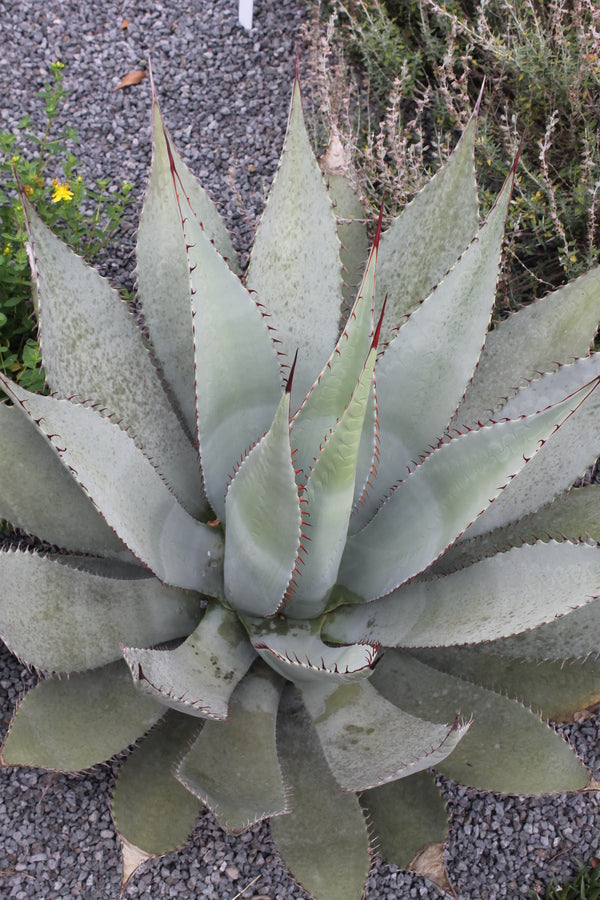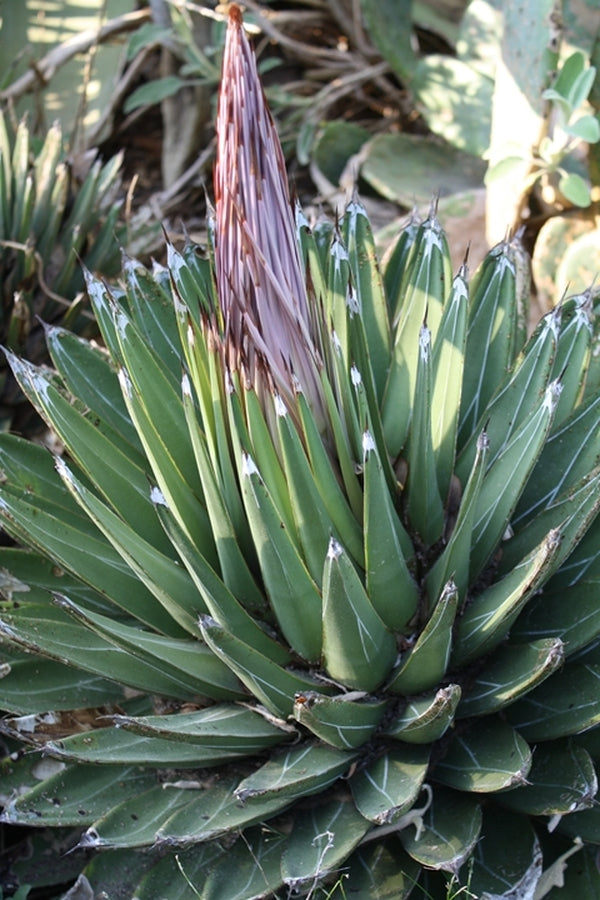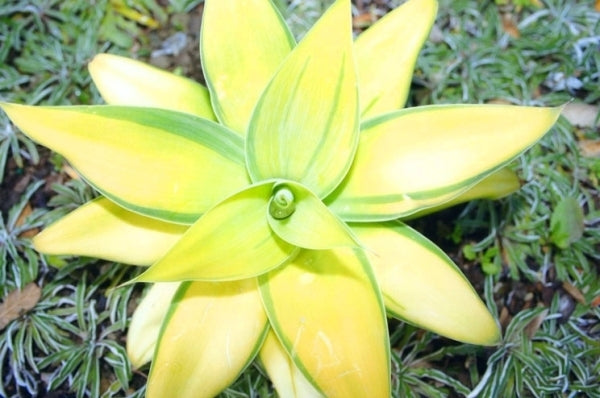The following article is part of a series geared toward entry-level gardeners. For deep dives into a variety of perennials that we have sold over the decades, visit our archive of in-depth perennial articles written by Tony Avent, Dr. Patrick McMillan, and other Plant Delights and JLBG experts. We also have transcripts of our Gardening Unplugged videos, recorded during our Open Nursery and Garden Days, that have great information for gardeners of all experience levels.
Century plants are wonderful architectural elements for the garden or container. Century Plants produce fascinating foliage in a variety of colors that can compliment any plant in the sun garden. There are blue agaves, green agaves, and variegated agaves with blue/white, green/yellow, or even more complex color combinations. The thick succulent leaves are deer-resistant and also make Century Plants very drought tolerant. The flowers, although produced only after 10 years or more of good garden conditions, are fascinating due to their extremely large size and their ability to attract hummingbirds. In our garden in the southeast U.S., our summer heat and humidity does not bother Century Plants, but our moist winter soils can prove problematic unless the plants are planted above grade or on a slope in well-drained soil.
Agave flexispina
Agaves are native to the southwestern United States and Mexico. We seek out Agave specimens that grow on the high altitude plains and mountains of this region where the local populations have evolved a tolerance for colder weather. We also collect rare and expensive variegated specimens and mass produce them for you. No longer do you have to pay hundreds of dollars for a cool white striped agave on Ebay. We have plenty of variegated agaves with stripes in white, cream, yellow, or light green to choose from. Now you can get them for much less at Plant Delights Nursery. One of our most popular agaves is Agave Parryi JC Raulston, an amazing specimen named after the late founder of the arboretum which bears his name.
Agave parryi 'J.C. Raulston'
Some agaves are smaller then a softball at maturity. These little guys prefer some space so they do not get over-run by bigger plants. Small agaves are great in rock gardens, fairy gardens, and in small containers. On the opposite end are truly monstrously proportioned agaves with leaves that reach out 6 to 8 feet from the central core of the plant. If you have room for a large agave, we highly recommend them. They are real rock stars in the garden and always stop people in their tracks. The large agaves can be planted alongside flowering perennials, ornamental grasses and small vines for additional color. Some combinations we like are Agave 'Silver Surfer' with purple or white echinacea, yellow coreopsis, pink or purple oxalis or any of the small or medium lantanas and verbenas. The airy seed heads of Muhlenbergia meld well with the large agaves too. In between the big fellas and the little guys are a wide range of volleyball to beachball sized agaves in a wide variety of colors and shapes. One favorite of ours is Agave 'JC Raulston' that is the size of a beachball and nearly as round. This highly structural selection looks great in the garden or in a large container with a low growing sedum spilling around it. 
Agave americana 'Opal'
One caveat to be aware of are the thorns that most agaves are armed with. Most agave leaves are tipped with cactus-like needles and additionally, some species have spines along the edge of the leaf. Agaves make great barrier plants, but will poke pets and kids without mercy. In short, don't plant an agave next to a slip-n-slide or a sandbox.
Are all agave winter hardy?
The hardiness of agave plants can vary depending on the specific species and the growing conditions. Some agave species are very winter hardy and can withstand freezing temperatures, while others are more sensitive to cold and may not survive frost.
Generally speaking, agave plants native to desert and arid regions are more cold-tolerant and can withstand colder temperatures than those native to tropical or subtropical regions. Agave species that are native to higher elevations in mountainous regions may also be more tolerant of cold temperatures.
Agave victoriae-reginae
It's important to note that even hardy agave species can suffer damage or death if exposed to prolonged periods of extreme cold or wet conditions. If you are considering planting agave in a cold climate, it's best to research the specific species you are interested in and consult with a local expert or nursery to determine if it is a good fit for your area.
Do deer eat agave?
Agave plants are generally considered deer-resistant due to their tough and spiny leaves. The sharp spines and tough fibers on the leaves can make them unappealing to deer, who may prefer to graze on softer plants. However, it's important to note that in times of food scarcity or when deer populations are particularly high, deer may eat almost anything, including agave.
It's also worth noting that while deer may avoid eating agave, other animals such as rabbits or rodents may still nibble on the leaves or roots, especially if other food sources are scarce. Additionally, young agave plants may be more vulnerable to grazing by deer and other animals, so it's important to protect them until they are established.
Overall, agave plants are generally considered to be a good choice for landscapes where deer are a problem, but it's important to remember that no plant is completely deer-proof in all situations.
Agave attenuata 'Kara's Stripes' PP 19,444
Are all agave drought tolerant?
Most species of agave are highly drought-tolerant and have evolved to survive in arid and semi-arid regions. They have adapted to store water in their thick, fleshy leaves, which enables them to withstand long periods of drought.
However, the degree of drought tolerance can vary depending on the species of agave and the growing conditions. Some agave species are more drought-tolerant than others, and even within a single species, individual plants may have varying degrees of drought tolerance.
In general, agave plants thrive in well-draining soil and full sun exposure. They are typically able to survive with very little water once established, but it's important to give them occasional deep watering to encourage healthy growth and prevent dehydration. Overwatering can be detrimental to agave plants, as their roots are prone to rot if kept constantly moist.
It's always a good idea to research the specific species of agave you are interested in and understand their specific growing requirements to ensure success in your garden or landscape.
Agave victoriae-reginae 'Lemonade'
What are the best agave for a beginner?
There are several types of agave that are relatively easy to grow and maintain, making them a good choice for beginners. Here are a few suggestions:
-
Agave americana - also known as the century plant, this species is one of the most common and widely cultivated agaves. It's hardy, drought-tolerant, and easy to care for. It grows in a rosette form and can reach up to 6 feet tall and wide.
-
Agave parryi - also known as the artichoke agave, this species is a smaller, more compact agave that is native to the southwestern United States. It's hardy and drought-tolerant, with gray-green leaves that have a beautiful sculptural quality.

Agave parryi ssp. truncata 'Bed of Nails' -
Agave victoriae-reginae - also known as the queen Victoria agave, this species is a slow-growing and compact agave that is native to Mexico. It has striking white markings on its dark green leaves, which make it a beautiful accent plant in any garden.
-
Agave attenuata - also known as the foxtail agave, this species is a non-spiny agave that is popular for its attractive, curved leaves that resemble the shape of a fox's tail. It's less cold-hardy than some other agave species, but it's still relatively easy to grow and care for.
All of these agave species are generally low-maintenance and drought-tolerant, making them good choices for beginner gardeners who are looking for a unique and striking addition to their landscape.

